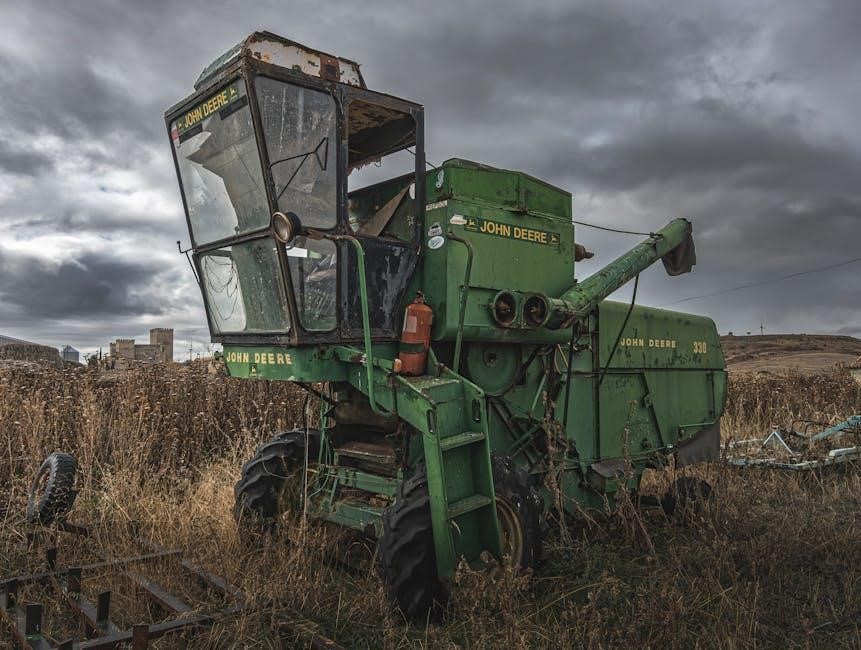Welcome to the John Deere 5075E Owners Manual, your comprehensive guide to understanding and operating your tractor effectively․ This manual provides essential information on safety, operation, and maintenance to ensure optimal performance and longevity of your machine․ By following the guidelines outlined in this manual, you can maximize efficiency and safety while operating your John Deere 5075E tractor․ Always refer to this manual for detailed instructions and troubleshooting tips to keep your tractor in top condition․
Overview of the Manual
The John Deere 5075E Owner’s Manual is a comprehensive guide designed to help owners, operators, and service personnel understand and utilize the tractor effectively․ It provides detailed information on the operation, maintenance, and troubleshooting of the tractor, ensuring safe and efficient use․ The manual is structured to cover all aspects of the tractor, from basic controls to advanced maintenance procedures, making it an essential resource for anyone working with the John Deere 5075E․
Key sections include safety precautions, operational guidelines, and maintenance schedules, all presented in a clear and organized manner․ The manual emphasizes the importance of understanding safety symbols and following proper procedures to prevent accidents and ensure longevity of the equipment․ By adhering to the guidelines outlined in the manual, users can maximize the performance and durability of their tractor, while also minimizing the risk of mechanical issues and operational hazards․
Whether you’re a seasoned operator or a new user, the John Deere 5075E Owner’s Manual serves as a valuable reference to help you get the most out of your tractor while maintaining safety and efficiency․
Key Features of the John Deere 5075E Tractor
The John Deere 5075E tractor is a powerful and versatile machine designed for agricultural and commercial applications․ It features a 4-wheel-drive system for superior traction and stability, ensuring efficient performance in various terrains․ Equipped with a 75-horsepower PowerTech M engine, the tractor delivers reliable power and fuel efficiency․ The engine is designed to meet emissions standards while maintaining optimal performance․ The tractor also includes a wet clutch for smooth and durable operation, reducing wear and tear on the transmission․ The 9F/3R SyncShuttle transmission provides easy shifting and precise control, making it suitable for both light and heavy-duty tasks․ Additionally, the tractor features an open-center hydraulic system with a flow rate of 12․7 gpm, supporting a wide range of implements․ The 5075E also offers a comfortable operator station with intuitive controls, ensuring ease of use and reduced fatigue during long working hours․

Safety Information and Precautions
Always wear a seat belt and protective equipment when operating the tractor․ Ensure all guards and shields are in place․ Be aware of surroundings to avoid accidents․ Follow proper startup and shutdown procedures․ Regularly inspect the tractor for damage or wear․ Keep loose clothing and long hair tied back․ Never allow passengers or children near the operating area․ Maintain a safe distance from slopes and uneven terrain․ Follow all safety symbols and instructions provided in the manual․ Properly maintain brakes and hydraulic systems for optimal performance․ Ensure the tractor is on level ground before servicing․ Avoid overloading the tractor beyond its capacity․ Stay alert and avoid operating the tractor when fatigued or under the influence of substances․ Keep emergency exits clear and accessible․ Always refer to the manual for specific safety guidelines related to attachments and implements․
Recognizing Safety Symbols and Signal Words
The John Deere 5075E Owners Manual uses specific safety symbols and signal words to communicate critical information․ These symbols are designed to alert operators to potential hazards and ensure safe operation․ Common symbols include a triangle with an exclamation mark (warning), a circle with a line through it (prohibition), and a hand or other graphic indicating a specific action․ Signal words like Operating the John Deere 5075E tractor requires adherence to essential safety guidelines to minimize risks and ensure safe usage․ Always read the manual thoroughly before operating the tractor․ Wear appropriate personal protective equipment (PPE), including safety glasses, gloves, and sturdy footwear․ Ensure the tractor is in good working condition by performing pre-operation checks, such as inspecting tires, brakes, and hydraulic systems․ Never allow children or unauthorized individuals to operate the tractor․ Keep loose clothing and long hair tied back to avoid entanglement with moving parts․ Always maintain three points of contact when entering or exiting the tractor․ Use the rollover protective structure (ROPS) and seatbelt if equipped, as they are critical for operator safety in case of a rollover․ Avoid operating the tractor on steep slopes or unstable terrain unless necessary, and always descend slopes with the tractor in low gear․ Keep the work area clear of obstacles and bystanders․ Follow all safety precautions when handling attachments or implements․ In case of an emergency, know the location of emergency stops and fire extinguishers․ Always turn off the engine and engage the parking brake before leaving the tractor unattended․ By following these guidelines, you can significantly reduce the risk of accidents and ensure a safe operating experience․ Operating the John Deere 5075E tractor requires careful preparation and attention to safety protocols․ Always perform pre-operation checks, ensure proper startup procedures, and maintain smooth control during use․ Adhere to load limits, monitor surroundings, and follow shutdown procedures to ensure safe and efficient operation․ Starting and stopping the John Deere 5075E tractor requires attention to proper procedures to ensure safety and optimal performance․ Before starting, conduct a pre-operation check, ensuring all controls are in neutral, the parking brake is engaged, and no attachments are active․ Turn the ignition key to the “Start” position, allowing the engine to idle briefly before increasing throttle․ Avoid sudden acceleration to prevent wheel spin or loss of control․ When stopping, reduce speed gradually, disengage the PTO, and shift into neutral․ Engage the parking brake and turn the key to the “Off” position․ Never leave the tractor unattended while running․ Proper shutdown helps prevent damage and ensures readiness for the next use․ Always refer to the manual for specific steps to avoid common mistakes during engine operation․ The John Deere 5075E tractor features an intuitive instrument cluster designed to provide clear feedback and control during operation․ Located on the dashboard, the cluster includes essential gauges such as an analog tachometer for engine speed, coolant temperature, and fuel level indicators․ Additional warning lights alert the operator to critical system statuses, such as low oil pressure or high temperature․ The controls are ergonomically arranged, with the steering wheel, throttle, and gearshift positioned for easy access․ Operators can monitor performance and adjust settings seamlessly, ensuring efficient and safe operation․ Familiarizing yourself with these components is crucial for maximizing productivity and maintaining equipment health․ Always consult the manual for detailed descriptions of each control and its function to ensure proper usage and troubleshooting․ Regular maintenance is crucial for the John Deere 5075E tractor’s longevity and performance․ Adhere to the recommended service schedule to prevent breakdowns and ensure optimal functionality․ Check oil, filters, and hydraulic fluid levels regularly․ The John Deere 5075E tractor requires specific maintenance at the 500-hour mark to ensure peak performance and longevity․ This interval typically includes replacing the engine oil and filter, as well as inspecting and replacing the coolant if necessary․ Additionally, the transmission and hydraulic fluids should be checked and changed if debris or degradation is detected․ Air filters, including the engine and cab air filters, should be inspected and replaced to maintain proper airflow and prevent dust ingestion․ Other critical tasks include inspecting the fuel lines for leaks, checking the battery terminals for corrosion, and verifying the condition of all hydraulic hoses and connections․ Tire pressure should also be checked and adjusted according to the recommended specifications․ It’s essential to use genuine John Deere parts to ensure compatibility and reliability․ Keeping a detailed service record is highly recommended for tracking maintenance and ensuring warranty compliance․ Regular maintenance is crucial to ensure the John Deere 5075E tractor operates efficiently and extends its lifespan․ Daily checks should include inspecting engine oil levels, coolant levels, and hydraulic fluid levels․ Ensure all filters, such as the engine air filter and fuel filter, are clean and free of debris․ Weekly, inspect the tire pressure, battery terminals, and belts for signs of wear or damage․ Every 50 hours, clean or replace the air filter, and check the fuel filter for contamination․ Additionally, sharpen mower blades (if equipped) and lubricate all moving parts to reduce friction and wear․ Following these maintenance tasks ensures reliable performance, reduces downtime, and keeps the tractor in prime working condition․ The John Deere 5075E features intuitive controls, including a steering wheel, accelerator, and PTO engagement lever․ Auxiliary hydraulic levers and a gear shift provide precise control over tractor functions and attachments․ The John Deere 5075E tractor features a robust hydraulic system designed for efficient operation of attachments and implements․ The system includes a gear-driven pump, hydraulic valves, and a reservoir․ Operators can control hydraulic flow using levers or switches, depending on the implement․ The hydraulic system operates at a maximum pressure of 2000 PSI, ensuring ample power for heavy-duty tasks․ Adjustments can be made to the hydraulic valve settings to customize flow rates and pressure for specific applications․ Regular checks of hydraulic fluid levels and filter cleanliness are essential for optimal performance․ Refer to the manual for detailed instructions on operating and adjusting the hydraulic system․ Always follow safety guidelines when working with hydraulic components to avoid potential hazards․ Proper maintenance ensures reliable operation and extends the lifespan of the system․ The John Deere 5075E tractor is equipped with a durable and efficient power train system, designed to deliver consistent performance in various agricultural applications․ The tractor features a 12F/4R SyncShuttle transmission, which provides smooth shifting and precise control․ The transmission includes a mechanical front-wheel drive (MFWD) and a differential lock, enhancing traction and stability on uneven terrain․ The power train is built to handle heavy loads while maintaining fuel efficiency․ Operators can choose from multiple speed ranges to match their workload, ensuring optimal productivity․ The transmission’s synchronized gears minimize noise and wear, while the shuttle lever allows for easy direction changes without clutching․ Regular maintenance, such as checking transmission fluid levels and filtering, is crucial to maintain performance․ The power train and transmission system is engineered to provide years of reliable service, making the John Deere 5075E a dependable choice for farming operations․ The troubleshooting section helps identify and resolve common issues with the John Deere 5075E tractor, covering engine, transmission, and hydraulic problems․ It provides diagnostic steps and solutions to minimize downtime, ensuring optimal performance and longevity․ Diagnosing engine and transmission issues in the John Deere 5075E tractor begins with identifying symptoms such as unusual noises, reduced performance, or erratic behavior․ Check for low fluid levels, worn belts, or clogged filters, which can cause engine stalling or poor acceleration․ For transmission problems, look for slipping gears, delayed engagement, or warning lights on the instrument cluster․ Use the tractor’s diagnostic system to retrieve error codes, which can pinpoint specific issues like sensor malfunctions or hydraulic pressure imbalances․ Always refer to the manual for recommended diagnostic tools and procedures․ If problems persist, consult a certified John Deere technician to avoid further damage․ Regular maintenance, such as fluid changes and filter replacements, can prevent many of these issues․ Addressing these problems promptly ensures the tractor operates efficiently and reliably for years to come․ Troubleshooting hydraulic and electrical systems in the John Deere 5075E tractor involves identifying common issues like fluid leaks, pressure drops, or electrical failures․ For hydraulic problems, inspect the system for leaks, blockages, or worn components․ Check hydraulic fluid levels and ensure filters are clean․ If the system lacks power, inspect the pump and valves for proper operation․ For electrical issues, verify fuses, circuit breakers, and connectors are functioning correctly․ Look for signs of corrosion or damage to wires and connections․ Use a multimeter to diagnose faulty sensors or relays․ Refer to the tractor’s diagnostic codes for specific guidance․ Addressing these issues promptly prevents downtime and ensures smooth operation․ Always follow safety guidelines when working with hydraulic and electrical systems, and consult the manual or a certified technician if problems persist․ The John Deere 5075E tractor comes with a comprehensive warranty program, ensuring coverage for parts and labor under specified conditions․ Dedicated service support through authorized dealers provides maintenance, repairs, and expert advice․ Referring to the manual ensures understanding of warranty terms and conditions for optimal coverage and service benefits․ The John Deere 5075E tractor is backed by a robust warranty program designed to protect your investment․ The warranty typically covers defects in materials and workmanship for a specified period, ensuring your tractor operates as intended․ It is essential to review the warranty section in the owner’s manual to understand the coverage duration, eligible repairs, and any conditions that may void the warranty․ Additionally, the manual outlines the process for filing warranty claims and the documentation required․ Regular maintenance, as detailed in the manual, is often a condition of warranty validity․ Understanding these terms ensures you can leverage the warranty effectively and maintain your tractor’s performance․ Always refer to the manual or consult a John Deere representative for specific details regarding your tractor’s warranty coverage․ Contacting John Deere customer support is a straightforward process designed to assist you with any questions or issues related to your 5075E tractor․ The owner’s manual provides detailed information on how to reach support, including phone numbers, website links, and authorized dealer locations․ For urgent inquiries, John Deere offers 24/7 customer service to address emergencies or critical operational issues․ You can also visit the official John Deere website for online support resources, such as FAQs, service guides, and live chat options․ When contacting support, it is helpful to have your tractor’s serial number and a clear description of the issue ready to ensure a prompt resolution․ Additionally, authorized John Deere dealers are equipped to provide personalized assistance, parts, and service, ensuring you receive reliable and expert support for your 5075E tractor․
Operating the John Deere 5075E Tractor
Starting and Stopping the Engine
Understanding the Instrument Cluster and Controls

Maintenance and Service Schedule
500-Hour Service Interval Requirements

Regular Maintenance Tasks for Optimal Performance

Tractor Controls and Functions
Hydraulic System Operation and Adjustments
Power Train and Transmission Overview


Troubleshooting Common Issues
Diagnosing Engine and Transmission Problems

Hydraulic and Electrical System Troubleshooting

Warranty and Service Support
Understanding the John Deere Warranty Terms
Contacting John Deere Customer Support


